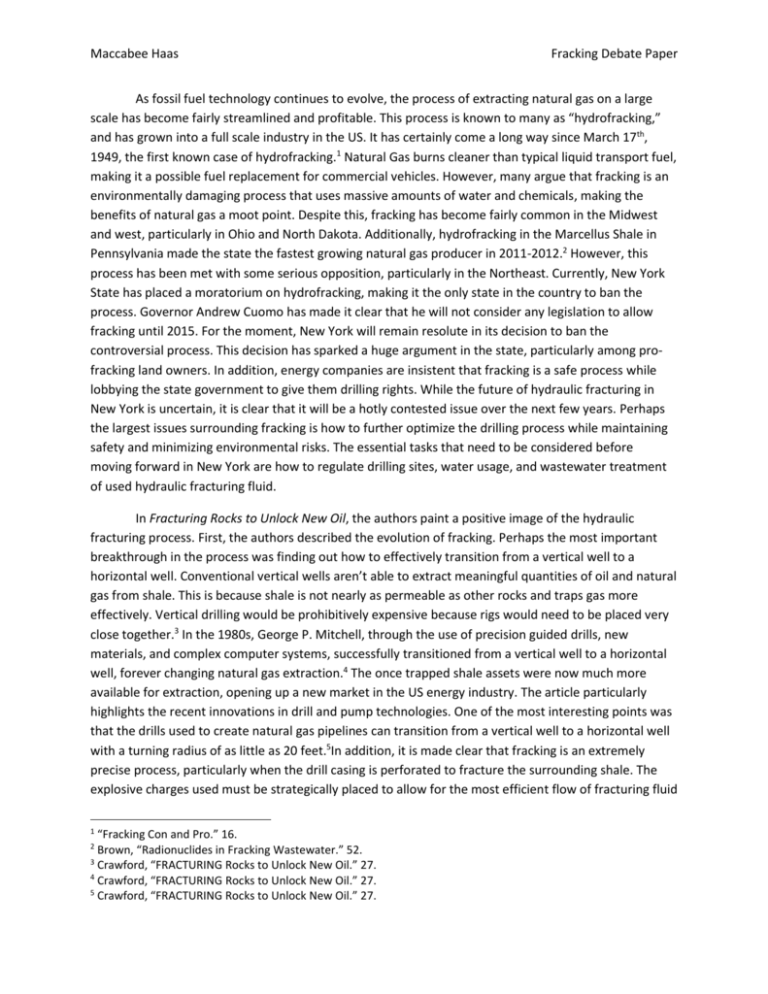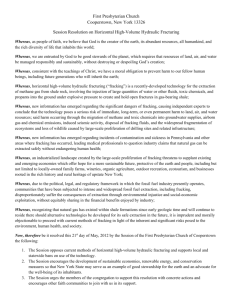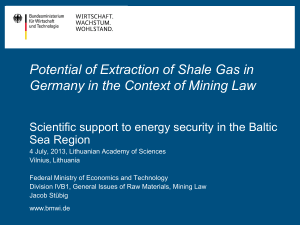FrackingDebatePaper - sustainabilitydebatesrpi
advertisement

Maccabee Haas Fracking Debate Paper As fossil fuel technology continues to evolve, the process of extracting natural gas on a large scale has become fairly streamlined and profitable. This process is known to many as “hydrofracking,” and has grown into a full scale industry in the US. It has certainly come a long way since March 17th, 1949, the first known case of hydrofracking.1 Natural Gas burns cleaner than typical liquid transport fuel, making it a possible fuel replacement for commercial vehicles. However, many argue that fracking is an environmentally damaging process that uses massive amounts of water and chemicals, making the benefits of natural gas a moot point. Despite this, fracking has become fairly common in the Midwest and west, particularly in Ohio and North Dakota. Additionally, hydrofracking in the Marcellus Shale in Pennsylvania made the state the fastest growing natural gas producer in 2011-2012.2 However, this process has been met with some serious opposition, particularly in the Northeast. Currently, New York State has placed a moratorium on hydrofracking, making it the only state in the country to ban the process. Governor Andrew Cuomo has made it clear that he will not consider any legislation to allow fracking until 2015. For the moment, New York will remain resolute in its decision to ban the controversial process. This decision has sparked a huge argument in the state, particularly among profracking land owners. In addition, energy companies are insistent that fracking is a safe process while lobbying the state government to give them drilling rights. While the future of hydraulic fracturing in New York is uncertain, it is clear that it will be a hotly contested issue over the next few years. Perhaps the largest issues surrounding fracking is how to further optimize the drilling process while maintaining safety and minimizing environmental risks. The essential tasks that need to be considered before moving forward in New York are how to regulate drilling sites, water usage, and wastewater treatment of used hydraulic fracturing fluid. In Fracturing Rocks to Unlock New Oil, the authors paint a positive image of the hydraulic fracturing process. First, the authors described the evolution of fracking. Perhaps the most important breakthrough in the process was finding out how to effectively transition from a vertical well to a horizontal well. Conventional vertical wells aren’t able to extract meaningful quantities of oil and natural gas from shale. This is because shale is not nearly as permeable as other rocks and traps gas more effectively. Vertical drilling would be prohibitively expensive because rigs would need to be placed very close together.3 In the 1980s, George P. Mitchell, through the use of precision guided drills, new materials, and complex computer systems, successfully transitioned from a vertical well to a horizontal well, forever changing natural gas extraction.4 The once trapped shale assets were now much more available for extraction, opening up a new market in the US energy industry. The article particularly highlights the recent innovations in drill and pump technologies. One of the most interesting points was that the drills used to create natural gas pipelines can transition from a vertical well to a horizontal well with a turning radius of as little as 20 feet.5In addition, it is made clear that fracking is an extremely precise process, particularly when the drill casing is perforated to fracture the surrounding shale. The explosive charges used must be strategically placed to allow for the most efficient flow of fracturing fluid 1 “Fracking Con and Pro.” 16. Brown, “Radionuclides in Fracking Wastewater.” 52. 3 Crawford, “FRACTURING Rocks to Unlock New Oil.” 27. 4 Crawford, “FRACTURING Rocks to Unlock New Oil.” 27. 5 Crawford, “FRACTURING Rocks to Unlock New Oil.” 27. 2 Maccabee Haas Fracking Debate Paper to permeate the rock. Overall, this article highlights the complexity of the hydraulic fracturing process, particularly the analysis and careful selection of all proposed infrastructure, making it easier to believe that fracking is a safe process. Fracturing Rocks to Unlock New Oil did an excellent job of describing the process of hydraulic fracturing, particularly all the planning time that goes into each fracking job. The author’s focus on the many technological advances in natural gas extraction gave a lot of credibility to a method I had previously assumed hasty and careless. From this article, it is apparent that energy companies put some serious thought into the geological effects of their fracturing of shale, and are able to use seismic analysis to collect real time data on rock formations being drilled. Furthermore, the ability to accurately model fracking using powerful software prior to drilling adds an additional factor of safety to all drilling operations, a luxury that has not always been available. This will allow energy companies to become more inherently environmentally friendly when extracting fossil fuels. One aspect of hydraulic fracturing that was barely mentioned was the water used to extract shale gas. According to the author, “Highvolume fracking uses more than 100,000 gallons of hydraulic fracturing fluid, which is 99 percent water.”6 In an era of decreasing quantities of potable water, this is quite alarming. Even more alarming is the fact that there were not currently alternative methods of decreasing water consumption for fracking. Moreover, when hydraulic fracturing fluid is extracted from wells, it oftentimes becomes contaminated with heavy metals and radioactive elements. This fluid has the potential to contaminate surrounding water supplies, which could have catastrophic consequences for the local environment. Despite this, it seemed like this issue was only given a cursory examination. This decreased the credibility of the author because he did not examine the negative aspects of fracking nearly as much as he did the positive aspects. It is always better to fully capture the issue instead of neglecting the parts of it you don’t agree with. In Radionuclides in Fracking Wastewater, Valerie Brown examines one of the biggest risks with hydraulic fracturing- the treatment and management of used hydraulic fracturing fluid. She posits that increased US natural gas extraction has (and will further) expedite the surface propagation of radioactive particles. The main focus of the article is on the Marcellus Shale formation, which stretches from western New York to Pennsylvania. This has been the center of fracking debate in the Northeastern US. Many argue that the risk of water contamination from hydraulic fracturing is too great to allow the process in New York. After fracking is completed at a drill site, the hydraulic fracturing fluid is extracted. Unfortunately, the current water treatment infrastructure is not equipped to handle the large amounts of wastewater generated by fracking, and the contaminated fluid needs to be stored in ephemeral lagoons, sometimes holding up to 10 million gallons of fluid.7 A 2013 study of these holding pits revealed that levels of beta radiation in one sample were in excess of 8 times the stated limit.8 While these ephemeral lagoons are temporary, they are radiological hotspots and pose a threat to the surrounding environment. Even if the water is treated the radiation often accumulates in stream sediment. In one case, outflow sediment at a wastewater discharge site was roughly 200 times more 6 Crawford, “FRACTURING Rocks to Unlock New Oil.” 29. Brown, “Radionuclides in Fracking Wastewater.” 52. 8 Brown, “Radionuclides in Fracking Wastewater.” 52. 7 Maccabee Haas Fracking Debate Paper radioactive than sediment upstream.9 Another proposal for the disposal of fracking waste is deep injection, where contaminated fluid is placed below the rock strata where fresh water is located. However, some argue that the large pressures required to force wastewater into injection wells could take upwards of a year to dissipate.10 This, like all of the current methods of treating water used in fracking, is not a complete solution. Rather, these methods do not treat water and remove harmful contaminants from water. However, some proposed methods plan to put fracking waste to “beneficial uses,” such as road de-icer, dust suppressant and road maintenance.11 This article not only addressed the huge problem that fracking waste presents to the environment, but also points out that the disposal of this waste is far from perfect. Overall, this provided a very detailed and supported argument of the dangers of hydraulic fracturing to the water supply. There were several examples of dangerous spikes in radiation levels in local water tables, which could have compounding negative environmental effects. In addition, the author did an excellent job of exposing the reality that there is not currently an effective method to safely process the waste generated by fracking. Another great aspect of this article was that it presented the argument in a very objective manner, which is a rare occurrence when dealing with this issue. This gives the reader a great opportunity to simply look at the empirical data without getting caught up in the political aspects of the issue. Additionally, while the negative impacts of fracking waste were presented, the positive uses for them was also mentioned, showing that there may be some hope for a more ecologically friendly system of processing this waste. By providing a hard hitting, factual analysis of wastewater management of fracking fluid, this article did a great job to influence my stance on the issue without ever mentioning politics. In Ian Ratcliffe’s Fracking is dangerous to the environment and throws good energy after bad, he argues that the current methods of extracting fossil fuels (including fracking) are very inefficient and, ultimately, not sustainable. A great point he brings up is that the global economy is geared towards infinite growth, at the cost of the environment and overall human welfare.12 These misaligned goals, he believes, will lead to the ultimate destruction of the environment. While this is a fairly extreme point of view, it raises several key questions about the directions in which we are moving as the 21st century progresses, particularly concerning future energy production. After reading many various articles on fracking in the US, and more specifically New York, I believe that the moratorium should not be lifted based on the current state of shale gas extraction. While the drilling process has been streamlined over the years, there is currently no plan in place to safely dispose of the wastewater generated by fracking. The risk of our drinking water becoming irradiated by fracking fluid is too great to allow these energy companies to drill before establishing solid disposal methods for all the radioactive materials that are brought up with natural gas. That being said, I do not object to pursuing safer ways to extract natural gas because it has potential to fuel commercial 9 Brown, “Radionuclides in Fracking Wastewater.” 52. Brown, “Radionuclides in Fracking Wastewater.” 53. 11 Brown, “Radionuclides in Fracking Wastewater.” 53. 12 Ratcliffe, “Fracking Is Dangerous to the Environment and Throws Good Energy after Bad.” 10 Maccabee Haas Fracking Debate Paper vehicles. I also like the creative uses for fracking brine, such as a de-icer, because it makes the waste stream more efficient. Bibliography Brown, Valerie J. “Radionuclides in Fracking Wastewater.” Environmental Health Perspectives 122, no. 2 (February 2014): A50–A55. doi:10.1289/ehp.122-A50. Crawford, Mark. “FRACTURING Rocks to Unlock New Oil” (n.d.): 24–29. Ratcliffe, Ian. “Fracking Is Dangerous to the Environment and Throws Good Energy after Bad.” Engineering & Technology (17509637) 8, no. 1 (February 2013): 25–25. “Fracking Con and Pro.” Mechanical Engineering 133, no. 6 (June 2011): 16–16.







